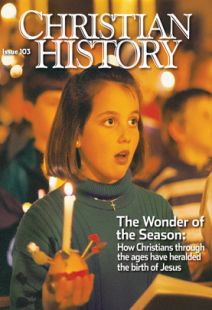Advent: Close Encounters of a Liturgical Kind
I CONFESS: as an adolescent, when my parents tried to impress on my two brothers and me the importance and the intricacies of Advent observance, I could hardly keep from rolling my eyes. In a country that spends its cold Decembers in hot pursuit of food, presents, and parties, the historical niceties of an ancient liturgical season seemed, well, irrelevant.
These days, on the other side of an evangelical conversion and nearly a decade of graduate study in church history, I've begun to see what excited my parents about Advent. I'm even entertaining the possibility that my own young family might benefit from an informed observance of Advent. (How to help my kids keep their eyes reverently lowered and their hearts in tune during such observance is, I confess, still pretty much beyond me. But that's a discussion for another day. I'm sure my parents are chuckling as they read this!)
In fact, Advent season presents a unique opportunity to many Protestants. It's like the once-a-year conjunction of two planets: It brings a great mass of Bible-loving, praise-and-worshipping, extemporaneously praying born-again Protestant Christians into close contact with a big chunk of the historic church's liturgy. Even many non-liturgical Protestants don't think twice about joining in the season's rituals, old as well as new. They pull out and count off advent calendars, listen to lectionary sermon themes and Bible readings, and recite set prayers at the dinner table around candles in meaningful hues of purple and rose.
So as Advent's four bright Sundays offer us ways to meditate on Christ's coming, let's explore the sustaining power of liturgical observance. In the words of John Bookser Feister, editor of AmericanCatholic.com, churchly seasons like Advent “tie our lives to Christians throughout history.” In a time of year filled with indulgence, the observance of centuries-old Christian practices can feed us in a deeper and better way.
Once upon a time, in 4th- and 5th-century Gaul and Spain, “Advent” was a preparation not for Christmas but for Epiphany, the early-January celebration of such diverse events in Jesus's life as his Baptism, the miracle at Cana, and the visit of the Magi. In those days, Epiphany was set aside as an opportunity for new Christians to be baptized and welcomed into the church. So believers spent Advent's forty days examining their hearts and doing penance.
It was not until the 6th century that Christians in Rome began linking this season explicitly to the coming of Christ. But at that time, and for centuries after, the “coming” that was celebrated was not the birth of Jesus, but his Second Coming. It was not until the Middle Ages that the church began using the Advent season to prepare to celebrate Christ's birth. And even then, this newer sense of the Lord's “advent” or coming did not supplant the older sense—the Second Coming. And the muted, Lent-like mood of penitential preparation remained alongside the joyous anticipation of Jesus' birthday.
So, the modern liturgy divides Advent into a period, through December 16th, during which the focus is Christ's Second Coming, and a period, from December 17th to the 24th, focusing on his birth. It starts with sobering passages and prayers about the apocalyptic return of the Lord in judgment. Then it moves to Old Testament passages foretelling the birth of a messiah and New Testament passages trumpeting John the Baptist's exhortations and the angels' announcements.
Every year these rich scriptural reminders and the traditional prayers that accompany them set my blood rushing a little faster and bring a rising excitement: Christ came with plenty of prior notice! Prophets and angels joined to proclaim his coming! And now I can join too, with the cloud of witnesses stretching back to apostolic times, in the same proclamation!
And in the protected, quiet times of meditation, I can respond as I imagine believers have done on every Advent since the tradition began: I can bow my head and prepare my heart to receive the One who is always present, but who seems distant in the busyness of the season. I can mourn for my hardness of heart. I can hope in his grace. And I can rejoice that in answer to the cry, “O come, O come, Emmanuel,” he came.
Would I really be able to do this—in the midst of December's commercial rush of lights, decorations, present-buying, and piped-in carols—without a gently insistent, weekly liturgical pattern? Maybe.
But I'm not rolling my eyes any more.
Update: I wrote this piece several years ago, when my children were small. Now that we have a few more Christmas seasons behind us, I am even more firmly convinced of the benefits of using the liturgical calendar.—CA.
By Chris Armstrong
[Christian History originally published this article in Christian History Issue #103 in 2012]
Chris R. Armstrong is professor of church history at Bethel Seminary, St. Paul, MN, and managing editor of Christian History.Next articles
The Real Twelve Days of Christmas
Celebrating Christ's birth with saints of the faith from Christmas Day until Epiphany
Edwin and Jennifer Woodruff TaitWealth, socialism, and Jesus
Churches in the nineteenth century were divided on how to reach those affected by the new economy
Janine Giordano DrakeConquest or conversion?
Missionaries worked hand-in-hand with economic interests but sometimes found their efforts being thwarted instead
Jeffrey B. WebbThe life and times of John Bascom
How social gospelers applied the teachings of Jesus to economic issues
William KostlevySupport us
Christian History Institute (CHI) is a non-profit Pennsylvania corporation founded in 1982. Your donations support the continuation of this ministry
Donate



